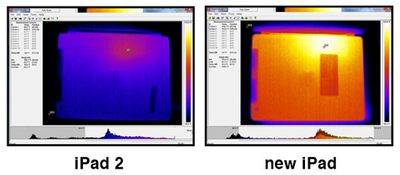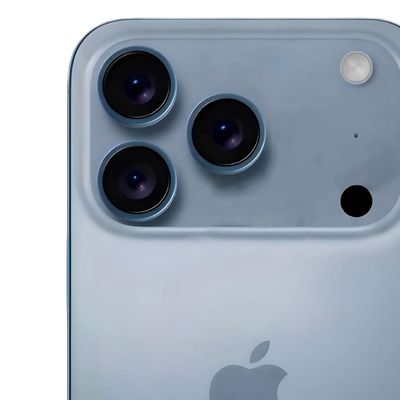Consumer Reports Finds New iPad Gets Warm, Can't Charge Under Heavy Loads
Following up on reports from earlier today that the outer shell of the iPad 3 gets warmer than the iPad 2, Consumer Reports found that their iPad 3 reached temperatures up to 116 degrees after running Infinity Blade II for 45 minutes.
The piece did note that the iPad felt "very warm but not especially uncomfortable if held for a brief period" during the testing process. In a statement earlier today, Apple said that the iPad was "operating well within our thermal specifications."

We ran our test while the new iPad was propped on the iPad Smart Cover, plugged in, and after it had run Infinity Blade II uninterrupted for about 45 minutes. The device's 4G connection was not turned on, though its Wi-fi link was. The ambient room temperature was about 72 degrees. (Apple recommends not using the iPad in environments over 95 degrees.)
When unplugged, the back of the new iPad reached temperatures as high as 113 degrees Fahrenheit. It was only when plugged in that it hit 116 degrees. The hottest areas weren't evenly distributed throughout the iPad's back, but were concentrated near one corner of the display as shown in the images taken from the rear of the device above.
Potentially more interesting is Consumer Reports' note that their new iPad didn't charge at all when the game was running. In fact, the battery continued to drain slightly under the extremely heavy CPU and GPU load from Infinity Blade II.
It seems that under extremely heavy processor usage, the iPad is unable to draw sufficient power from its USB connection to both power the device and charge the battery simultaneously.
Popular Stories
Despite being more than two years old, Apple's AirPods Pro 2 still dominate the premium wireless‑earbud space, thanks to a potent mix of top‑tier audio, class‑leading noise cancellation, and Apple's habit of delivering major new features through software updates. With AirPods Pro 3 widely expected to arrive in 2025, prospective buyers now face a familiar dilemma: snap up the proven...
Apple plans to release an all-new super thin iPhone this year, debuting it alongside the iPhone 17, iPhone 17 Pro, and iPhone 17 Pro Max. We've seen pictures of dummy models, cases, and renders with the design, but Lewis Hilsenteger of Unbox Therapy today showed off newer dummy models that give us a better idea of just how thin the "iPhone 17 Air" will be.
The iPhone 17 Air is expected to be ...
A developer has demonstrated Windows 11 ARM running on an M2 iPad Air using emulation, which has become much easier since the EU's Digital Markets Act (DMA) regulations came into effect.
As spotted by Windows Latest, NTDev shared an instance of the emulation on social media and posted a video on YouTube (embedded below) demonstrating it in action. The achievement relies on new EU regulatory...
Apple's iPhone development roadmap runs several years into the future and the company is continually working with suppliers on several successive iPhone models simultaneously, which is why we often get rumored features months ahead of launch. The iPhone 17 series is no different, and we already have a good idea of what to expect from Apple's 2025 smartphone lineup.
If you skipped the iPhone...
Apple seeded the third beta of iOS 18.5 to developers today, and so far the software update includes only a few minor changes.
The changes are in the Mail and Settings apps.
In the Mail app, you can now easily turn off contact photos directly within the app, by tapping on the circle with three dots in the top-right corner.
In the Settings app, AppleCare+ coverage information is more...
Apple will unveil the iPhone 17 Pro in a new Sky Blue color, the same color that debuted on the latest M4 MacBook Air models Apple released in March. That's according to the leaker Majin Bu.
Concept mockup from Majin Bu
Writing on his website, Bu claims that "sources close to the supply chain confirm that several iPhone 17 Pro prototypes have been made in various colors, with Sky Blue...
While the iPhone 17 Pro and iPhone 17 Pro Max are not expected to launch until September, there are already plenty of rumors about the devices.
Subscribe to the MacRumors YouTube channel for more videos.
Below, we recap key changes rumored for the iPhone 17 Pro models as of April 2025:
Aluminum frame: iPhone 17 Pro models are rumored to have an aluminum frame, whereas the iPhone 15 Pro and ...






















